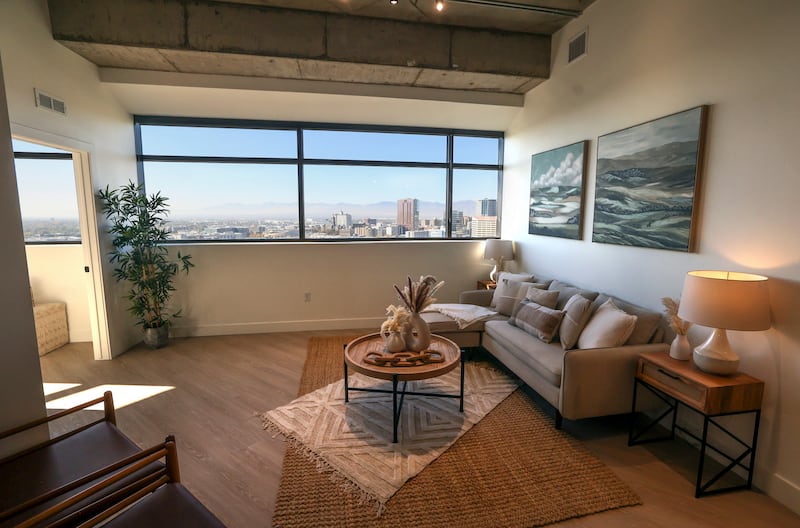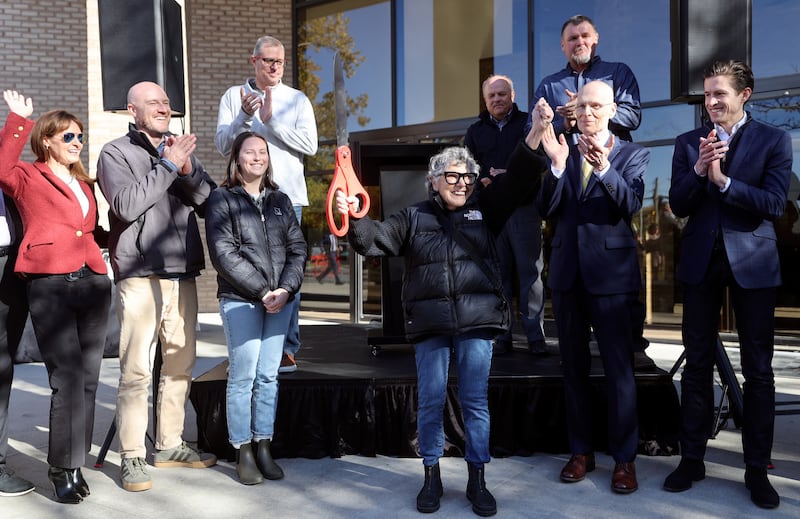Mask mandates and social distancing have long passed, but as Chris Parker stood in a room full of housing experts and leaders from other cities, he pointed out that Utah’s housing crunch might be the top lingering impact of the COVID-19 pandemic.
That was about the time when many Utahns lost the ability to afford a home, including almost every average Salt Lake City resident. Nothing like it had ever happened, and it forced the need to invest in housing in ways Utah had never seen before, said Parker, co-director of the Perpetual Housing Fund, a Utah program that seeks to erase barriers in homeownership, as he stood on the 14th floor of the 515 Tower (515 E. 100 South) in Salt Lake City’s Central City neighborhood.
Utah leaders and housing experts gathered there Thursday to celebrate the completion of the first phase of the building’s conversion from an office tower to a deeply affordable housing project called Arbor 515, home to a unique potential solution to the state’s housing crisis.
“This is probably the tallest response to COVID in the state,” Parker said.
Turning an old office building into housing
The project is different from most others, as it tests an interesting affordable housing concept called "tenant wealth initiative." The program essentially provides renters with affordable housing while also giving them back a share of what a developer would receive from the property. It was created through a Perpetual Housing Fund partnership with the Community Housing of Utah and several public, private and philanthropic entities.
Residents also receive a share if the building is ever sold or refinanced, and any benefits accrued could go toward the purchase of certain properties. This allows renters to build equity like a homeowner, which can be used to build generational wealth, Parker explained.

Leaders of Utah’s Perpetual Housing Fund zeroed in on the 515 Tower for new housing testing this concept, as it became clear that University of Utah Health, the building’s largest tenant, planned to move out. Their departure left it virtually vacant, and Parker said leaders fell in love with the 45-year-old building and its “striking views” of the city as they explored viable candidates.
Its location was also key as it’s near a pair of bus lines and in the “eastern thumb” of the downtown, as Salt Lake City Mayor Erin Mendenhall put it. She said the city was informed about the concept a few years ago and agreed to help out.
“I was already in love with the concept,” she said, explaining that her father worked out of the building before his death when she was 13. “I was then raised by a single mother — could’ve had to lose our housing over the course of the next several years of my childhood. ... That risk was always there on our horizon.”
The nonprofit fund officially acquired the property in 2023 and began the difficult work to transform many of its floors into affordable housing a year ago. It wasn’t an easy task because the building had a wider floor plate than the typical housing complex, which is an issue that makes it difficult to turn most office buildings into new housing units.
That meant getting to the finished product required “creative layouts,” which its interior was also turned into an all-electric system, Parker explained.

“These buildings take quite a bit larger contingency. That being said, the benefits of using an existing building are pronounced,” he said, noting that the project’s one-year renovation timeline was half the time that would be needed to build a new tower of its size, and it delivered new affordable housing units well before any other project could have.
Its 96 affordable units range in size from studio to four bedrooms, and one to two bathrooms, for people making 25% to 60% of the area’s median income. The building also includes an on-site gym, while some of its floors are dedicated to coworking spaces and mixed uses, including a Montessori school that opened in the building and a planned restaurant.
Saving the building also prevented sending its pieces to the landfill, he added. He expects that the building will end up on the National Register of Historic Places once it qualifies for the list, beginning in the 2030s. The listing could allow for federal and state tax credits for any work that preserves the building’s history, since it’s a housing complex.
A new housing model?
Only about 9% of Utahns can now afford a median-priced home in the state, according to Gov. Spencer Cox, a statistic he said will require more housing to overcome. His administration aims to build 35,000 starter homes before the end of his term, and 150,000 homes altogether.
That goal has also run into economic headwinds that the governor hopes can be cleared up with lower interest rates, but he also unveiled a new plan this week to reduce barriers to new construction.
Arbor 515 can be a “life-changing” project toward that goal because of its unique model, he added after touring the complex.
The Perpetual Housing Fund has already identified “several more parcels” across the state to set up a similar structure, including about 1,000 units in Salt Lake City, Parker said. He’d like to see it become a “regional” housing solution.
However, Cox, who shared the project site with many national housing experts, says it could be a model for the rest of the U.S.
“Hopefully, we can start to scale in a way that makes a dent,” he said. “This is a great project ... but it’s a drop in the bucket compared to what we need.”

